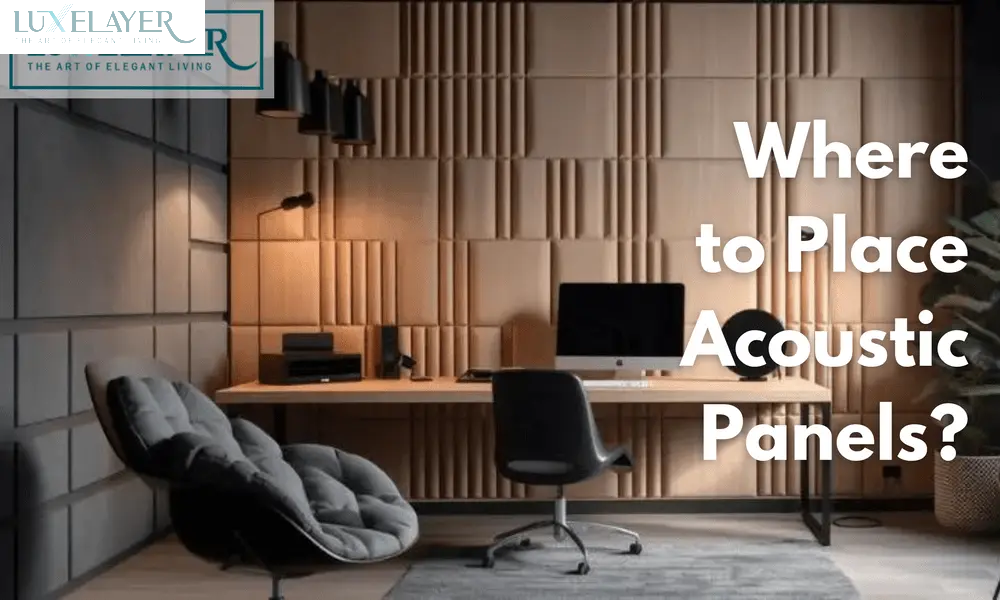Acoustic panels are essential for creating optimal sound environments in various settings, from home theaters to offices. Proper placement of these panels can significantly improve sound quality by reducing echoes and controlling reverberations.
LuxeLayer provides a variety of aesthetic and functional acoustic panel solutions that are both simple to install and effective. This guide will cover the best practices for positioning acoustic panels to achieve the desired acoustic treatment.
Understanding Acoustic Panels
What Are Acoustic Panels?
The purpose of acoustic panels is to absorb sound waves, reduce noise, and control reverberations in a space. They are commonly formed from materials such as foam, fabric, wood, and fiberglass. LuxeLayer's acoustic panels combine aesthetic appeal with high functionality, ensuring they fit seamlessly into any interior design.
Why are Acoustic Panels Important?
Acoustic panels are crucial in environments where sound quality matters, such as recording studios, home theaters, offices, and public spaces. They help in: Reducing Echoes and Reverberations: Ensuring clear and undistorted sound. Enhancing Privacy: By minimizing sound transmission between rooms,. Improving Acoustic Quality: Creating a more pleasant and intelligible audio experience.Types of Acoustic Panels
Wood Veneer Panels
LuxeLayer’s wood veneer panels provide a natural, elegant appearance while effectively absorbing sound. They are ideal for spaces where aesthetics and acoustic performance are both priorities.WPC Panels
Wood-plastic composite (WPC) panels are moisture-resistant, making them suitable for areas prone to dampness. These panels are durable and simple to maintain.
Fabric-Wrapped Panels
Fabric covers these panels, which come in a variety of colors and patterns. They offer high sound absorption and add a decorative touch to the room.The Science Behind Acoustic Panels
How Acoustic Panels Work
Acoustic panels work by absorbing sound waves, preventing them from reflecting off rigid surfaces. This absorption reduces echo and reverberation, creating a clearer sound environment. The effectiveness of a panel depends on its placement and the materials used.Sound Reflection Points
Sound waves reflect off concrete surfaces like walls, ceilings, and floors. Identifying these reflection points is key to effective acoustic treatment. To maximize their sound-absorbing capabilities, place panels at these points.Optimal Placement for Acoustic Panels
Identifying Reflection Points
To determine the best placement for acoustic panels, identify the primary reflection points in your room: First Reflection Points: These are the areas where sound first reflects off a surface. These points are typically housed in walls adjacent to speakers or sound sources. Secondary Reflection Points: These include the ceiling and back walls, where sound waves continue to reflect after initial contact.Placement Strategies
Home Theaters
In home theaters, place panels at the first reflection points on the side walls and ceiling. This setup will minimize echoes and improve sound clarity.Offices
For office spaces, focus on placing panels on walls where conversations tend to reflect. This approach will enhance speech intelligibility and reduce noise levels.Recording Studios
Recording studios often use a combination of wall-mounted and ceiling-mounted panels. To ensure optimal sound quality, panels should cover both reflection points and areas around recording equipment.Public Spaces
In larger public spaces like restaurants or conference rooms, distribute panels evenly across walls and ceilings to create a balanced acoustic environment.DIY Installation Tips
Preparation
Measure the space: Accurate measurements ensure you order the right number of panels. Clean the Surface: Make sure walls and ceilings are free from dust and debris before installation.Installation Methods
Impaling Clip Method
Mark the Spots: Indicate where each panel will be placed. Attach Clips: Use screws to secure the impaling clips to the wall. Mount the panels: Press the panels firmly onto the clips.Z-Clip Method
Mount Z-Clips: Secure one part of the Z-clip to the panel and the other to the wall. Hang the Panels: To ensure a secure fit, slide the panels onto the wall-mounted clips.Ceiling Installation
For ceiling installations, use wire-hook suspension or cloud mounting brackets to hang panels at the desired height.Maintaining Acoustic Panels
Regular Cleaning
Dusting: Regularly dusting panels is important to maintain their appearance and performance. Spot Cleaning: For fabric panels, use a mild cleaner to remove any stains or marks.Inspection
Periodically check panels for any signs of damage or wear. Replace or repair panels as needed to ensure continued acoustic effectiveness.Common Mistakes to Avoid
Overcrowding
Avoid placing too many panels in one area. This can lead to an overly dampened sound environment. Distribute panels evenly to achieve balanced acoustics.Ignoring Reflection Points
Failing to identify and cover key reflection points can result in suboptimal sound quality. Always prioritize these areas during installation.Improper Height Placement
To maximize their effectiveness, place panels at the correct height, typically at ear level for wall-mounted panels.Conclusion
Proper placement of acoustic panels is essential for achieving the best sound quality in any environment. By understanding the science behind acoustic treatment and following best practices for installation, you can create a space with superior acoustics. LuxeLayer’s range of acoustic panels offers both functionality and aesthetic appeal, making them the perfect choice for any soundproofing project.FAQs
How many acoustic panels do I need?
The number of panels depends on the size of your room and the level of soundproofing required. Larger rooms, as well as those with harder surfaces, may require more panels.
Can I install acoustic panels myself?
Yes, LuxeLayer panels are easy to install yourself. Follow our step-by-step guide for the best results.
What materials are best for acoustic panels?
Materials like foam, fabric, wood veneer, and WPC are effective. Choose based on your specific needs and aesthetic preferences.
How do I maintain acoustic panels?
Regular dusting and spot cleaning will keep your panels looking and functioning at their best. Inspect periodically for any damage.
Can acoustic panels be customized?
Yes, LuxeLayer offers a variety of colors and designs to match your interior decor.
Where should I place acoustic panels in a home theater?
For optimal sound quality, install panels at the first reflection points on the side walls and ceiling.



